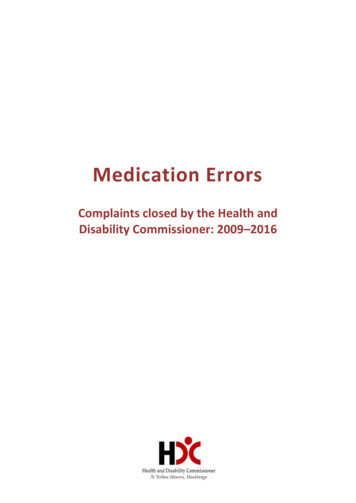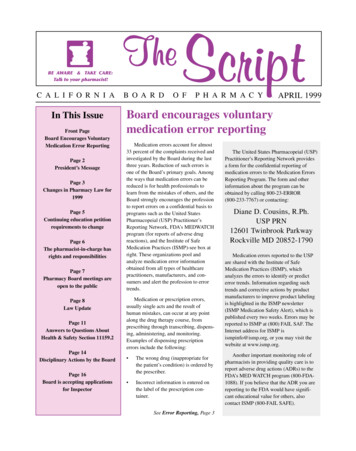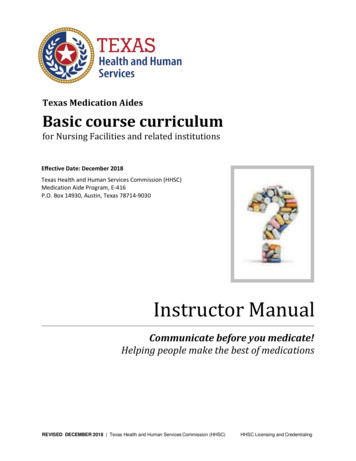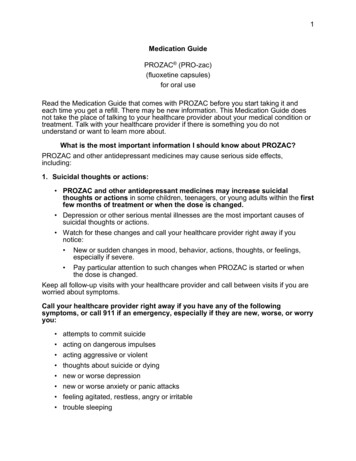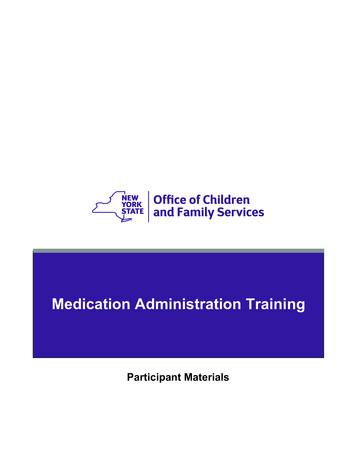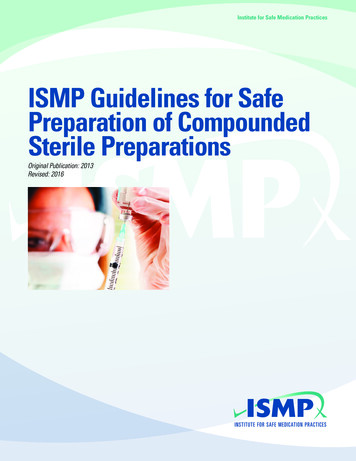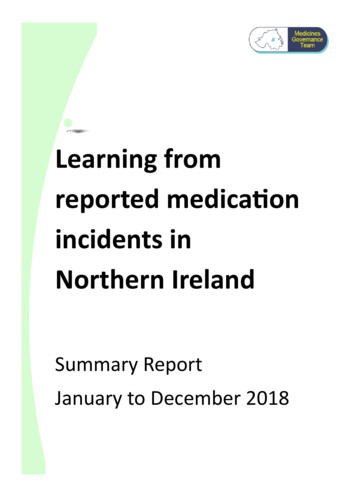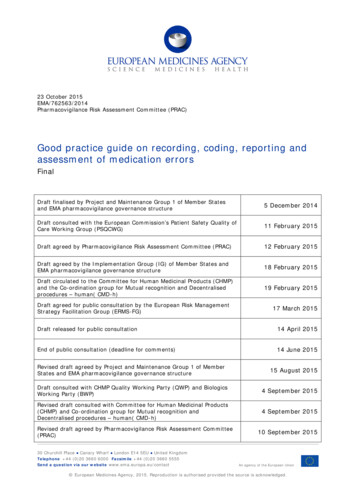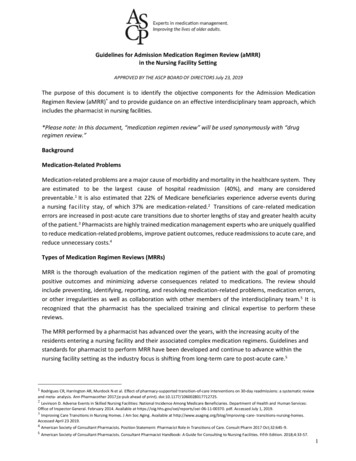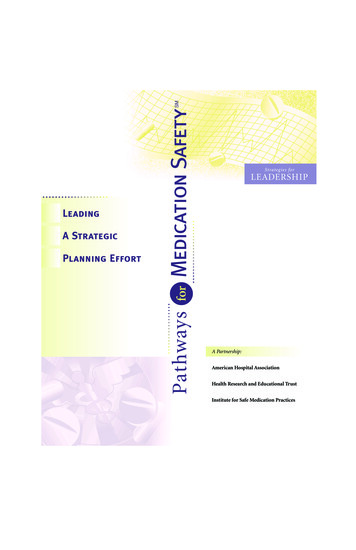
Transcription
12/2/024:07 PMPage 1Planning EffortforA StrategicPathwaysLeadingMedication SafetySMTool 1 TOC and SummaryA Partnership:American Hospital AssociationHealth Research and Educational TrustInstitute for Safe Medication Practices
Tool 1 TOC and Summary12/2/024:07 PMPage 2Pathways.for.Medication SafetysmLeading a Strategic Planning EffortPathways for Medication Safety:Leading a Strategic Planning EffortTable of Contentspage 1.iExecutive Summarypage 1.iiSection 1.1 — Why Hospitals Need a Strategic Plan for Medication Safetypage 1.1.1Section 1.2 — A Model Strategic Plan for Medication Safetypage 1.2.1 Goal #1 – Create, communicate and demonstrate a culture of safety.1.2.2 Goal #2 – Improve error detection, reporting and the use of information.1.2.3 Goal #3 – Evaluate where technology can reduce the risk of medication errors.1.2.4 Goal #4 – Reduce the risk of errors with high-alert medications.1.2.5 Goal #5 – Establish a blame-free environment.1.2.6 Goal #6 – Involve the community.1.2.8 Goal #7 – Establish a controlled formulary.1.2.9Section 1.3 — Creating an Organization-Specific Strategic Planfor Medication Safety Involve Key People Assess your Current Position Review the Model Plan Map a Strategy for the Future Select Change Projects Implement the Strategic Plan Monitor PerformanceAttachments1.A1-A6 – Culture Surveys and Staff Questionnaires About Error Reporting1.B – Creating a Culture of Safety Through Executive WalkRoundsTM1.C – Patient Safety Officer Job Description1.D – Medication System Analyze-ERR 1.E – Triggers and Markers1.F – Guideline for Maximum Adult Dose Limits of Parenteral Chemotherapy1.G – Checklist/Action Plan for the Management of High-Alert Medications1.H – Policy for a Nonpunitive, System-Based Adverse Drug EventReporting Program1.J – Medication Safety Pledge for Patients1.K – Prioritization Criteria for Selecting Medication Safety Change Projects1.L – Timeline for Implementing a Strategic Plan for Medication Safety1.M – Readings Related to Leading a Strategic Planning Effortpage 1.3.11.3.21.3.31.3.41.3.51.3.61.3.71.3.7page 1.L.11.M.1www.medpathways.info1.i2002 American Hospital Association, Health Research & Educational Trust,and the Institute for Safe Medication Practices
Tool 1 TOC and Summary12/2/024:07 PMPage 3Section 1 —Executive Summary.Pathways.for.Medication SafetysmLeading a Strategic Planning Effort“Only 12 percent ofthe hospitals thatwere part of theself assessmentactually had specificmedication safetyelements in theirstrategic plan. Thistool will help morehospitals adopt anddevelop specificmedication safetySummaryThis tool is designed to help hospital executiveswork with various members of their institutionsto formally identify specific medication safetystrategic initiatives. By incorporating medicationsafety objectives into the organization-widestrategic plan, hospital leadership sends a clearmessage—that this is an important goal, a goalthat all members of the organization shouldstrive to attain. By enumerating specificinitiatives, the strategic plan also establishes aframework for tracking progress toward themedication safety goal.GoalsThe primary goal of Leading a StrategicPlanning Effort is to promote the fact thatmedication safety should be a criticalcomponent in any hospital’s overall strategicplan. The tool also provides guidance for howto incorporate medication safety into thestrategic planning process.objectives as partof their strategicContextplanning process.”In November 1999, the American HospitalAssociation (AHA) Board of Trustees identifiedpatient safety as a strategic priority andestablished measurable medication safetyimprovement goals as its first objective. Toaccomplish that objective, AHA formed astrategic partnership with the Institute for SafeMedication Practices (ISMP). In May 2000,AHA and ISMP together distributed theISMP Medication Safety Self Assessment toall hospitals in the United States.1—Mary Pittman,Dr. P.H. President,Health Researchand EducationalTrustThe results of the self-assessment showed thatspecific medication safety objectives wereincluded in the Chief Executive Officer’sstrategic plans in only 12 percent of respondinghospitals. Furthermore, about half of allrespondents did not feel that their Boards ofTrustees demonstrated a commitment topatient safety by approving a safety plan,encouraging practitioner error reporting, orsupporting system enhancements, includingtechnology, that were likely to reduce errors.2As a result, the Pathways for MedicationSafety: Leading a Strategic Planning Effortwas developed to provide organizations with amodel strategic plan for medication safety.Leading a Strategic Planning Effort is one ofthree related tools designed to help hospitalsreach the broader objective of creatingnonpunitive, system-based approaches toreduce adverse events and errors. The otherPathways tools are: Looking Collectively at Risk. This toolis designed to help hospital personnelidentify potential medication safety risks.Administrators/managers, physicians, nurses,pharmacists, and risk managers can use thematerials in this tool to pinpoint specificareas of weakness in their medicationdelivery systems. This initial processcan provide the foundation for amultidisciplinary effort to design andimplement system improvements.www.medpathways.info1.ii2002 American Hospital Association, Health Research & Educational Trust,and the Institute for Safe Medication Practices
Tool 1 TOC and Summary12/2/024:07 PMPage 4Pathways.for.Medication SafetysmLeading a Strategic Planning Effort Assessing Bedside Bar-Coding Readiness.This tool will help hospitals betterunderstand what is required to apply thisemerging technology in health care and howto best implement a bedside bar coded drugadministration system. The materials willhelp organizations understand the issuesrelated to bar coding in health care, assesstheir readiness, and move towards aneffective implementation.ContentsSection 1.1 provides a brief background onstrategic planning for medication safety, whichanswers two basic questions:1. Why is strategic planning for medicationsafety important to every hospital?2. Why should every hospital devote significantresources to medication safety?Section 1.2 is a Model Strategic Plan forMedication Safety, which includes examples ofseven long-term goals and suggested activitiesto achieve each goal.Section 1.3 guides hospitals though aprocess to use the model plan to designan organization-specific strategic planfor medication safety.The tool is accompanied by numerousattachments and references that may behelpful during the strategic planning processor during the implementation of the plan.In some cases, the attachments have beenprovided by organizations that havesuccessfully implemented one of thesuggested activities in the Model StrategicPlan for Medication Safety.Process1. Involve Key People: Establish a core teamto review the model strategic plan anddevelop an organization-specific strategicplan for medication safety. Multidisciplinaryrepresentation on the core team is essentialto the success of the strategic planningprocess.2. Review Materials: Distribute Pathwaysfor Medication Safety: Leading a StrategicPlanning Effort to each member of the coreteam as well as to others who will influenceor implement the plan. Ask them tofamiliarize themselves with the introductorymaterial and Sections 1.1-1.3 to anyplanning sessions.3. Map a Strategy for the Future: Followthe guidelines provided in Section 1.3 todevelop your organization’s strategicinitiatives. When necessary, refer to Section1.2 for information regarding the long-termgoals, boundaries, enduring advantages, etc.4. Select Change Projects: For each longterm goal, have the core team select changeprojects that are most likely to lead toachievement of the goal.5. Implement the Strategic Plan: Havethe core team establish a communicationplan to effectively disseminate the strategicplan to everyone who needs to know aboutit and to secure a commitment to makingit happen.6. Monitor Performance: Have the coreteam work out a timetable to periodicallyreview the medication safety strategic planand monitor the progress toward achievingeach goal.www.medpathways.info1.iii2002 American Hospital Association, Health Research & Educational Trust,and the Institute for Safe Medication Practices
Tool 1 TOC and Summary12/2/024:07 PMPage 5Pathways.for.Medication SafetysmLeading a Strategic Planning EffortOutcomesAt the conclusion of a review of the materialsthe reader should be able to address thefollowing: Why a medication safety component iscritical to any hospital’s strategic plan.Who should be involved in the process.What processes will assist participants inmaking appropriate judgments anddecisions.How to identify goals, communicate relevantchanges in processes and procedures, andevaluate progress toward goals.Endnotes1. ISMP Medication Self Assessment (Huntingdon Valley,PA: Institute for Safe Medication Practices, 2000).Available at: www.ismp.org.2. Judy L. Smetzer, “Preliminary Key Findings from theISMP Medication Safety Self AssessmentTM Will Be Usedto Determine Provider Training Needs.” Article indevelopment.www.medpathways.info1.iv2002 American Hospital Association, Health Research & Educational Trust,and the Institute for Safe Medication Practices
12/2/024:08 PMPage 1Planning EffortSection 1.1 —Why Hospitals Need a StrategicPlan for Medication SafetyforA StrategicPathwaysLeadingMedication SafetySMTool 1 Section 1 and 2 and 3A Partnership:American Hospital AssociationHealth Research and Educational TrustInstitute for Safe Medication Practices
Tool 1 Section 1 and 2 and 312/2/024:08 PMPage 1Section 1.1 —Why Hospitals Need a Strategic Planfor Medication SafetyPathways.for.Medication SafetysmLeading a Strategic Planning EffortA strategy defines the organization’s intent — where it wants to be inthe future — and encourages everyone to work together to achievecommon goals. Its focus reflects the organization’s values and priorities.Why is strategic planning for medicationsafety important to every hospital? While the hectic pace of health care oftenforces immediate patient needs andpriorities to take precedence over planningfor the future, the strategic planning processallows an organization to strike a muchneeded balance between managing theshort-term needs of patients and planningthe long-term goals of the organization toensure patient safety.Safe medication use requires carefulplanning and cannot be achieved if all of theorganization’s resources are spent meetingthe patient’s immediate needs.Errors involving the use of medicationscomprise the largest single cause of medicalerrors in hospitals.1determined in part by the strength of theeconomic case for reducing medication errors.2Rest assured, a sizable body of evidencesuggests that medication errors are bad businessbecause they are costly in both human andfinancial terms.For example, in one study: 3 Why should every hospital devotesignificant resources to medication safety?Considering the fundamental mission of anyhospital—to provide patients with the bestpossible care—arguing the case in favor ofreducing medication errors is hardly necessaryfrom a human compassion standpoint. However, the extent to which a hospital commitsresources toward this effort could beTwo serious medication errors that causedpatient harm occurred with every 100admissions.An average of 4.6 days were added to thesepatients’ lengths of stay.An extra 5,857 per event was added tothese patients’ costs.In a 700-bed teaching hospital, theextrapolated cost of preventable adversedrug events over the course of a year was 2.8 million dollars. This staggering numberdoes not include costs associated withinvestigating the adverse events, mounting adefense for associated claims, and payingsettlements or awards.Other organizational costs associated withserious medication errors include:4,5 Increased malpractice insurance premiums.Marketing costs associated with minimizingwww.medpathways.info1.1.12002 American Hospital Association, Health Research & Educational Trust,and the Institute for Safe Medication Practices
Tool 1 Section 1 and 2 and 312/2/024:08 PMPage 2Pathways.for.Medication SafetysmLeading a Strategic Planning Effort the impact of negative news media coverage.Higher employee turnover.Decreased operational efficiency due topracticing defensive medicine.Patients also bear some of the financial burdenfrom serious medication errors. Additionalcare may be required due to long- or shortterm disability and a loss of income mayresult, not just for the patient, but also fortheir caregivers.6,7New external pressures to improve patientsafety also make a strategic focus onmedication safety good business. Consumers’lack of confidence in the health care industryspurred the Institute of Medicine’s report,To Err is Human: Building a Safer HealthSystem.8 In that report, the committeesuggested that the best strategy for improvingsafety is to exert external pressure on the healthcare industry to make errors so costly in termsof maintaining market share and reputationthat organizations would be compelled to takeaction and invest appropriate resources toimprove safety. As a result: Employers are now questioning how muchmoney they spend on health benefits. 9Employers also want to know how muchmoney spent on health benefits is due torecovery from preventable events.Coalitions of private and public purchasersof health care have been created to putpressure on the health care industry todo more about patient safety. For example,the Leapfrog Group, a coalition of largeemployers, plans to reward hospitals thatuse effective computerized prescriber orderentry (CPOE) systems.10,11A final approach to determine if a strategicinvestment in medication safety is goodbusiness is to conduct a cost-effectivenessanalysis.12 This approach goes beyondunderstanding and measuring the directand indirect costs associated with medicationerrors and their prevention in monetaryterms. It expands the perspective in humanterms, taking into consideration importantsocietal standards, such as freedom fromaccidental injury.In the end, the successful business model forhealth care must focus on medication safety,not just because it makes sense financially,but also because it is the right thing to do.Endnotes1. To Err is Human: Building a Safer Health System, eds.Linda T. Kohn, Janet M. Corrigan, and Molla S.Donaldson (Washington: National Academy Press, 2000).2. J.E. Turnbull, and James Mortimer, “The Business Casefor Safety,” In Lessons in Patient Safety, eds. Lorri Zippererand Susan Cushman (Chicago: National Patient SafetyFoundation, 2001), 21-26.3. David Bates, Nathan Spell, David Cullen, et al.,“The Cost of Adverse Events in Hospitalized Patients,”Journal of the American Medical Association 277, no. 4(1997): 307-311.4. William B. Weeks, Julia Waldron, Tine Foster, Peter D.Mills, and Erik Stalhandske, “The Organizational Costs ofPreventable Medical Errors,” Joint Commission Journal ofQuality Improvement 27, no. 10 (2001): 533-539.5. Philip Schneider, Maja Gift, Yu-Ping Lee, ElizabethRothermich, and Bruce Sill, “Cost of Medication-RelatedProblems at a University Hospital,” American Journal ofHealth System Pharmacies 52, no. 21 (1995): 2415-2418.6. Eric J. Thomas, David M. Studdert, Joseph P.Newhouse, et al., “Costs of Medical Injuries in Utah andColorado,” Inquiry 36 (Fall 1999): 255-64.7. Diana Brahams, “Medical Errors: A Costs Burden onSociety,” Medico-Legal Journal 68 (Part 1 2000): 1-2.www.medpathways.info1.1.22002 American Hospital Association, Health Research & Educational Trust,and the Institute for Safe Medication Practices
Tool 1 Section 1 and 2 and 312/2/024:08 PMPage 3Pathways.for.Medication SafetysmLeading a Strategic Planning Effort8. To Err is Human: Building a Safer Health System, eds.Linda T. Kohn, Janet M. Corrigan, and Molla S.Donaldson (Washington: National Academy Press, 2000).9. William B. Weeks, Julia Waldron, Tine Foster, Peter D.Mills, and Erik Stalhandske, “The Organizational Costs ofPreventable Medical Errors,” Joint Commission Journal ofQuality Improvement 27 (No. 10 2001): 533-539.10. Jane Metzger and Fran Turisco, ComputerizedPhysician Order Entry: A Look at the Vendor Marketplaceand Getting Started (Washington, DC: The LeapfrogGroup, 2001). Available at: http://www.informaticsreview.com/ thoughts/cpoe-leap.html. AccessedNovember 6, 2002.11. Peter Kilbridge, Emily Welebob, and David Classen,Overview of the Leapfrog Group Evaluation Tool forComputerized Physician Order Entry (Long Beach, CA:First Consulting Group, 2001). Available tion.pdf. Accessed November 6, 2002.12. William B. Weeks, Julia Waldron, Tine Foster, Peter D.Mills, and Erik Stalhandske, “The Organizational Costs ofPreventable Medical Errors,” Joint Commission Journal ofQuality Improvement 27, no. 10 (2001): 533-539.www.medpathways.info1.1.32002 American Hospital Association, Health Research & Educational Trust,and the Institute for Safe Medication Practices
12/2/024:08 PMPage 4Planning EffortSection 1.2 —Model Strategic Plan forMedication SafetyforA StrategicPathwaysLeadingMedication SafetySMTool 1 Section 1 and 2 and 3A Partnership:American Hospital AssociationHealth Research and Educational TrustInstitute for Safe Medication Practices
Tool 1 Section 1 and 2 and 312/2/024:08 PMPage 1Section 1.2 —Model Strategic Plan forMedication Safety.Pathways.for.Medication SafetysmLeading a Strategic Planning Effort“Leading a StrategicPlanning Effortwill have specialrelevance forhospital leadershipin that it isdesigned to helphospital executiveswork with variousmembers of theirinstitution toformally identityspecific medicationsafety strategicThe Model Strategic Plan for MedicationSafety is comprised of seven long-term goals:1. Create, communicate, and demonstrate aleadership-driven culture of safety.2. Improve error detection, reporting, anduse of the information to improvemedication safety.3. Evaluate where technology can helpreduce the risk of medication errors.4. Reduce the risk of errors with high-alertmedications prescribed and administeredto high-risk patient populations or atvulnerable periods of transfer throughthe health care system.5. Establish a blame-free environment forresponding to errors.6. Involve the community in medicationsafety initiatives and medication selfmanagement programs.7. Establish a controlled formulary in whichthe selected medications are based moreon safety than cost.initiatives.”– Judy Smetzer, RNVice PresidentInstitute for SafeMedicationPracticesEach long-term goal is followed by a briefdescription of: Boundaries – Definite parameters basedon current limitations and capabilities thathelp clarify exactly what should beaccomplished.Enduring Advantages – Sustained,positive influences on the system thatbenefit patients, staff, and the organization. Potential Barriers/Threats –Conditions or situations that could impedeprogress in achieving the desired goal.Change Projects – A specific tactic,activity, program, or action plan that willhelp achieve the strategic long-term goal.The suggested long-term goals and changeprojects are provided as examples only. Theyare not intended to represent a comprehensivelist of all possible endeavors related tomedication safety that merit attention.However, the goals and change projects wereselected as prime examples because: Most are widely applicable in hospitalsregardless of size or financial capabilities.The potential for improving medicationsafety is high if the suggested changeprojects are i
suggests that medication errors are bad business because they are costly in both human and financial terms. For example, in one study:3 Two serious medication errors that caused patient harm occurred with every 100 admissions. An average of 4.6 days were added to these patients’ lengths of stay. An extra 5,857 per event was added to
